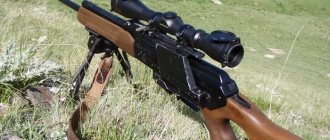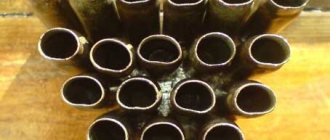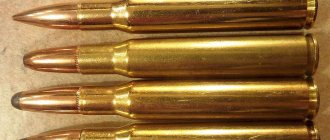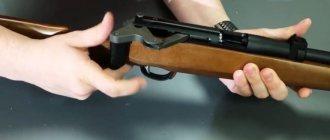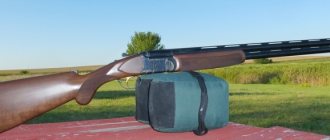Types of malware 212
The VPO 212 carbine is available in several varieties, although the main design features and technical characteristics do not differ between them.
The differences between gun modifications are the length of the barrel and the material from which the stock is made. For example, if you wish, you can buy a VPO 212 not only with a classic stock made of natural walnut, but also a very stylish and original model with a stock made of colored laminate, painted in a bright orange hue.
But in most cases, hunters prefer to choose a firearm not by appearance, but by functionality. If we talk about VPO 212, then this model is presented in two varieties: with a barrel length of 520 mm (classic version) and in a more advanced version, with a barrel length of 650 mm. The latest variety is called VPO 212-04.
Review of VPO-209
The VPO-209 smoothbore carbine was developed and produced at the Molot OJSC enterprise in Vyatskie Polyany on the basis of the AKM and has many characteristics similar to it.
VPO-209 is produced in smoothbore caliber 366 TKM, which was originally developed by the Tekhkrim enterprise for the VPO-208 carbine, which was created on the basis of the SKS carbine.
Due to its caliber, VPO-209 is purchased under a smoothbore license, so buyers who want to purchase it do not need to wait for a five-year ownership period to obtain a rifled license, which is its greatest advantage.
The 366 TKM cartridge is designed for hunting animals weighing up to 200 kg, at a distance of up to 150 meters.
The abbreviation TKM in the name of the cartridge indicates the developers of both the city of Izhevsk and OJSC “Molot”, Vyatskie Polyany.
The cartridge is developed on the basis of the cartridge case 7.62×39 mm mod. 1943. The caliber of the 336 cartridge is indicated in fractions of an inch, which in the metric system corresponds to the designation 9.5 × 37.5 mm.
The 366 TKM cartridge is ideal for effective hunting of animals weighing over 200 kg at a distance of up to 150 meters. Produced by Tekhkrim, Izhevsk (TK) and OJSC Molot, Vyatskie Polyany. The current cartridge is a modification of the 7.62 caliber cartridge produced in 1943. It is produced complete with a “Dary” lead bullet, weighing 13.5 g, with a “Gexa” semi-jacketed bullet, weighing 15.5 g, and in 2016, production and sales of cartridges with a “Konus” semi-jacket bullet, weighing 15 g, resumed. .
The 366 TKM caliber cartridges are produced with different types of bullets: the Dary lead bullet weighing 13.5 grams, the Hexa semi-jacketed bullet weighing 15.5 grams, and the Conus semi-jacketed bullet weighing 15 grams. Hunter or shooter, everyone can choose a cartridge to suit their needs.
The VPO-209 carbine, due to its appearance, as well as due to its capabilities built into it by the manufacturer, attracts the attention of buyers and ensures constant demand for this model of weapon. https://www.youtube.com/embed/Oeu3N8KK3R4
Carbine VPO-125, first acquaintance
Some time ago I purchased a VPO-125 carbine, this is Vepr-1B in 223rem caliber. I have never gone hunting with it yet; after purchasing it, I once went to the shooting range to lead to a normal fight, but it only brought me vertically, because... I thought about setting the horizontal line using a front sight, but I didn’t have the appropriate tool. As a result, I went to the shooting range again with the intention of finally shooting the weapon, and decided to set the horizontal using the rear sight, fortunately the VPO-125 has a horizontally adjustable rear sight, similar to the RPK rear sight. Looking ahead, I will say that half a turn of the rear sight flywheel was enough for the necessary adjustment.
To bring it to normal combat, I used 55gr FMJ cartridges from the Tula plant. Shot from a table rest, distance 50 meters.
VPO-125, 50 meters Considering that mechanical sighting devices were used in artificial lighting conditions, I consider the result to be quite good. Unfortunately, my eyesight is failing me, I see the black circle dimly and I was aiming approximately in the middle. I am sure that when using an optical sight the result will be more interesting.
I set it to “0” at 50 meters because in this case, at distances up to 150 meters inclusive, the adjustment of the aiming point is approximately 2cm. For hunting purposes, this adjustment is not important and you can aim without taking this adjustment into account, and with open sights, hunting with such a caliber at long distances probably does not make sense. Below in the photo is a plate of excesses for the Tula cartridge .223rem fmj 55gr according to the Strelok ballistic calculator.
So as not to forget.
A post shared by Vladimir (@forestspb) on Jan 16, 2022 at 10:21am PST
When there is optics, there will probably be a different bringing distance to “0”.
For the first time, I can only describe my impressions of the carbine itself with a few theses:
1. The accuracy of a cheap cartridge suits me quite well; unlike the VPO-205, mechanical sights work here and are needed. On the VPO-205 they annoyed me, I solved the problem by installing a collimator sight.
2. With my height (192cm), I would like to install a longer forend, perhaps this issue can be solved with a butt adjustable in length.
3) After using a 12 gauge, the barrel becomes unusually hot and your left hand is constantly burned; if you plan to fire many shots, you need to use gloves.
4) Weight doesn’t cause me any problems personally, although I expected the worst. Apparently because I constantly use the smoothbore Vepr (VPO-205), and it is, to put it mildly, not the lightest.
5) My carbine definitely likes the Tula FMJ cartridges more than the Barnaul FMJ, I took turns firing several series of shots with both, and the Tula ones showed a consistently better (albeit not much) accuracy result.
Part two. Checking the battle at a distance of 100 - 200 meters.
So, I did the reduction to normal combat at the shooting range, to zero at a distance of 50 meters. I was pleased with the result of the zeroing, but the question of how the weapon would perform at long distances haunted me, so within a day I found myself at the shooting range.
I set control targets at 100 and 200 meters, additionally set a target at 75 meters (wrongly, I thought it was 50) and using improvised means I designated a target at a distance of 150 meters - a car tire with a plastic container filled with ice inside.
Target environment
I shot from a position sitting at the table (see photo), the position is uncomfortable due to my height, the seat is dug in too close to the table, it cannot be moved. He fired the magazine from point-blank into the bag. The sight is standard mechanical, Tula 55gr fmj cartridges.
Having made several warm-up shots at a target at 75 meters, I shot a series at 100 meters. I tried to choose the aiming point on the target in the area of the shoulders-middle of the head, but, unfortunately, my vision is already failing me, the target is blurry and talking about the aiming point can be very, very conditional. However, I was pleased with the first episode under these conditions, see photo below. During further shooting, the accuracy was worse, apparently the eyes were tired, but not a single shot went beyond the target or into the “milk”, the dispersion was mainly vertical.
Distance 100 meters
Then he fired three shots at the target at a distance of 150 meters. The target is a canister inside a vertically standing tire; in the photo of the target environment it can be seen at the very bottom of the red circle at 200 meters. Unfortunately, I didn’t see the canister itself at this distance; it simply blended in with the snow, so I simply aimed at the middle of the tire. All three shots hit the target. I didn’t shoot at this target again.
Distance 150 meters
Most of all I was interested in shooting at 200 meters. The first series of four shots all went lower and only one bullet caught the lower edge of the target. It’s difficult to name the aiming point, because the target was completely blurred and completely covered by the front sight, but I tried to aim at shoulder level. The next attempt was to aim at the upper section of the target, all the bullets hit the lower part. Then I alternately set the value “2” and “3” on the rear sight, but hits also came to the lower part. I set the value to “4” and tried to aim under the edge of the target, the hits came approximately there, right at the shield under the target. The last attempt was with the rear sight “4” and the aiming point approximately shoulders-head, a series of four shots - the result was four hits from 10 and above, see in the photo below.
Distance 200 meters
I’ll say it again that the target blurs and it’s impossible to fix the aiming point, you can only catch on the cut, but it’s problematic to catch on the top cut, since the target is completely covered by the front sight.
Then, for fun, I shot at the scattered rubbish and decided to shoot the remaining five rounds while standing with rapid fire at a target at 75 meters. Out of five shots, at least four hit the “ten” area, one went down. I’m not sure that I can repeat such a series, but that’s how it happened. In the photo below, at the bottom of the target, there are seven “irons” - these are part of the “warm-up” shots at the very beginning of shooting, the edge of the target was lifted by the wind.
Distance 75 meters
I didn’t make any adjustments to the sight during the shooting; overall, everything was fine, but we need to think about the difference obtained in practice with a ballistic calculator.
Based on the results of this shooting:
- I wanted to buy an optical sight with greater force, I am sure that the shooting result will increase significantly, I think even three hundred meters with optics will not be a problem.
- I am pleased with the carbine I bought and concluded that shooting from a carbine just for fun is much more interesting than shooting from a smoothbore.
All the best and good marksmanship!
